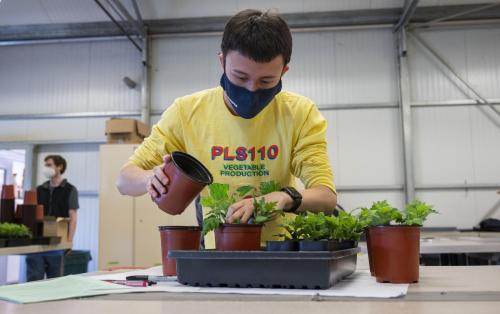What is Controlled Environment Agriculture?
The term controlled environment agriculture (CEA) encompasses a variety of systems that take a technology-based approach to farming. CEA can range from simple shade structures and hoop houses through greenhouses to full indoor or vertical farms. The most advanced systems are fully automated, closed loop systems with controlled lighting, water and ventilation. CEA also encompasses common practices such as plastic film over field-grown crops, nets or shade structures and aquaponics systems that integrate fish or aquaculture with plant production.
CEA systems are designed to provide optimal growing conditions for crops and prevent disease and pest damage. In indoor systems with artificial lighting, crops may be grown hydroponically, in which roots are bathed in nutrient-dense water, or aeroponically where roots are regularly misted with water and nutrients.
Why is CEA important?

A resilient food system must include all scales and types of agriculture. As climate change has the potential to disrupt traditional agricultural production and consumers are increasingly seeking unique products, Controlled Environment Agriculture can be an important part of a robust and nutritious food supply across the globe.
CEA has the potential to produce high-quality food close to consumers, using minimal water and other inputs. Already many of the fresh tomatoes, herbs and leafy greens we enjoy are grown in controlled environments ranging from shade structures to greenhouses. And greens grown fully under lights in enclosed indoor systems are increasingly available for the marketplace.
Looking ahead, CEA is likely to be an important addition to more traditional outdoor growing systems. CEA can minimize inputs such as water, nutrients and chemicals, while also reducing the potential for food borne pathogens, as well as save on labor costs. CEA systems can also be placed in urban areas not suitable for traditional agriculture, bringing food production closer to consumers and making use of existing space.
The UC Davis connection
UC Davis faculty, staff and student researchers are partnering with CEA companies, equipment suppliers, start-ups and others to facilitate CEA development for a sustainable future. Faculty across the college focus on aspects of CEA ranging from reducing energy use in indoor systems to breeding crops specifically for CEA. In addition, many longstanding research programs and faculty members across departments are poised to contribute to the future of CEA.
Teaching also is critical. As the industry grows, so does the need for talent. UC Davis has invested in a teaching facility allowing students to gain hands-on experience to prepare them for jobs in this growing industry.
